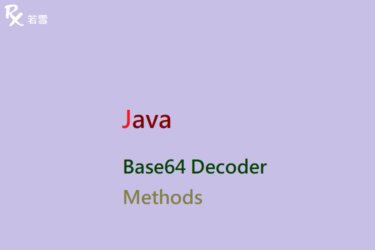Table of Contents
ToggleUnit Test AssertJ Map with Examples
驗證包含、不包含指定的元素等方法,使用 流式斷言,可以大幅提升斷言效率,減少程式碼的撰寫, AssertJ Map Unit Test with Examples 讓開發者體驗更流暢的驗證斷言方法,本篇增加了範例,透過單元測試來驗證產出結果。
檔案目錄
./
+- src
+- test
| +- org
| +- ruoxue
| +- spring_boot_168
| +- test
| +- assertj
| +- map
| +- UnitTestAssertJMapWithExamplesTest.java 單元測試
Examples AssertJ Map Unit Test 斷言映射的主要目的是取得映射的正確元素以進行斷言。
containsAnyOf
Examples AssertJ Map Unit Test 驗證包含任一元素,若不成立,則會拋出 AssertionError 。
@Test
public void containsAnyOf() {
Map<String, Integer> map = new HashMap<String, Integer>();
map.put("Grape", 18);
map.put("Kiwifruit", 19);
map.put("Lemon", 20);
System.out.println(map);
assertThat(map).containsAnyOf(entry("Papaya", 28), entry("Grape", 18), entry("Strawberry", 38));
Map<Integer, Integer> intMap = new HashMap<>();
intMap.put(1, 18);
intMap.put(2, 19);
intMap.put(3, 20);
System.out.println(intMap);
assertThat(intMap).containsAnyOf(entry(9, 28), entry(1, 18), entry(3, 20));
}{Grape=18, Kiwifruit=19, Lemon=20}
{1=18, 2=19, 3=20}containsEntry
Examples AssertJ Map Unit Test 驗證包含指定的元素,若不成立,則會拋出 AssertionError 。
@Test
public void containsEntry() {
Map<String, Integer> map = new HashMap<>();
map.put("Grape", 18);
map.put("Kiwifruit", 19);
map.put("Lemon", 20);
System.out.println(map);
assertThat(map).containsEntry("Grape", 18);
Map<Integer, Integer> intMap = new HashMap<>();
intMap.put(1, 18);
intMap.put(2, 19);
intMap.put(3, 20);
System.out.println(intMap);
assertThat(intMap).containsEntry(1, 18);
}{Grape=18, Kiwifruit=19, Lemon=20}
{1=18, 2=19, 3=20}doesNotContainEntry
Examples AssertJ Map Unit Test 驗證不包含指定的元素,若不成立,則會拋出 AssertionError 。
@Test
public void doesNotContainEntry() {
Map<String, Integer> map = new HashMap<>();
map.put("Grape", 18);
map.put("Kiwifruit", 19);
map.put("Lemon", 20);
System.out.println(map);
assertThat(map).doesNotContainEntry("Papaya", 28);
Map<Integer, Integer> intMap = new HashMap<>();
intMap.put(1, 18);
intMap.put(2, 19);
intMap.put(3, 20);
System.out.println(intMap);
assertThat(intMap).doesNotContainEntry(9, 99);
}{Grape=18, Kiwifruit=19, Lemon=20}
{1=18, 2=19, 3=20}containsOnly
Examples AssertJ Map Unit Test 驗證包含全部元素,順序不需要保持一致,若不成立,則會拋出 AssertionError 。
@Test
public void containsOnly() {
Map<String, Integer> map = new HashMap<>();
map.put("Grape", 18);
map.put("Kiwifruit", 19);
map.put("Lemon", 20);
System.out.println(map);
assertThat(map).containsOnly(entry("Kiwifruit", 19), entry("Lemon", 20), entry("Grape", 18));
Map<Integer, Integer> intMap = new HashMap<>();
intMap.put(1, 18);
intMap.put(2, 19);
intMap.put(3, 20);
System.out.println(intMap);
assertThat(intMap).containsOnly(entry(2, 19), entry(3, 20), entry(1, 18));
}{Grape=18, Kiwifruit=19, Lemon=20}
{1=18, 2=19, 3=20}containsAllEntriesOf
Examples Unit Test AssertJ Map 驗證包含全部元素,大小可以小於,若不成立,則會拋出 AssertionError 。
@Test
public void containsAllEntriesOf() {
Map<String, Integer> map = new HashMap<>();
map.put("Grape", 18);
map.put("Kiwifruit", 19);
map.put("Lemon", 20);
Map<String, Integer> map2 = new HashMap<>();
map2.put("Grape", 18);
map2.put("Kiwifruit", 19);
System.out.println(map);
System.out.println(map2);
assertThat(map).containsAllEntriesOf(map2);
Map<Integer, Integer> intMap = new HashMap<>();
intMap.put(1, 18);
intMap.put(2, 19);
intMap.put(3, 20);
Map<Integer, Integer> intMap2 = new HashMap<>();
intMap2.put(1, 18);
intMap2.put(2, 19);
System.out.println(intMap);
System.out.println(intMap2);
assertThat(intMap).containsAllEntriesOf(intMap2);
}{Grape=18, Kiwifruit=19, Lemon=20}
{Grape=18, Kiwifruit=19}
{1=18, 2=19, 3=20}
{1=18, 2=19}containsExactly
Examples Unit Test AssertJ Map 驗證包含全部元素,順序也需要保持一致,若不成立,則會拋出 AssertionError 。
@Test
public void containsExactly() {
Map<String, Integer> map = new LinkedHashMap<String, Integer>();
map.put("Grape", 18);
map.put("Kiwifruit", 19);
map.put("Lemon", 20);
System.out.println(map);
assertThat(map).containsExactly(entry("Grape", 18), entry("Kiwifruit", 19), entry("Lemon", 20));
Map<Integer, Integer> intMap = new LinkedHashMap<Integer, Integer>();
intMap.put(1, 18);
intMap.put(2, 19);
intMap.put(3, 20);
System.out.println(intMap);
assertThat(intMap).containsExactly(entry(1, 18), entry(2, 19), entry(3, 20));
}{Grape=18, Kiwifruit=19, Lemon=20}
{1=18, 2=19, 3=20}containsExactlyEntriesOf
Examples Unit Test AssertJ Map 驗證包含全部元素,順序也需要保持一致,若不成立,則會拋出 AssertionError 。
@Test
public void containsExactlyEntriesOf() {
Map<String, Integer> map = new HashMap<>();
map.put("Grape", 18);
map.put("Kiwifruit", 19);
map.put("Lemon", 20);
Map<String, Integer> map2 = new HashMap<>();
map2.put("Grape", 18);
map2.put("Kiwifruit", 19);
map2.put("Lemon", 20);
System.out.println(map);
System.out.println(map2);
assertThat(map).containsExactlyEntriesOf(map2);
Map<Integer, Integer> intMap = new HashMap<>();
intMap.put(1, 18);
intMap.put(2, 19);
intMap.put(3, 20);
Map<Integer, Integer> intMap2 = new HashMap<>();
intMap2.put(1, 18);
intMap2.put(2, 19);
intMap2.put(3, 20);
System.out.println(intMap);
System.out.println(intMap2);
assertThat(intMap).containsExactlyEntriesOf(intMap2);
}{Grape=18, Kiwifruit=19, Lemon=20}
{Grape=18, Kiwifruit=19, Lemon=20}
{1=18, 2=19, 3=20}
{1=18, 2=19, 3=20}containsExactlyInAnyOrderEntriesOf
Examples Unit Test AssertJ Map 驗證包含全部元素,順序不需要保持一致,若不成立,則會拋出 AssertionError 錯誤, Unit Test AssertJ Map Example 提供範例參考。
@Test
public void containsExactlyInAnyOrderEntriesOf() {
Map<String, Integer> map = new HashMap<>();
map.put("Grape", 18);
map.put("Kiwifruit", 19);
map.put("Lemon", 20);
Map<String, Integer> map2 = new HashMap<>();
map2.put("Lemon", 20);
map2.put("Grape", 18);
map2.put("Kiwifruit", 19);
System.out.println(map);
System.out.println(map2);
assertThat(map).containsExactlyInAnyOrderEntriesOf(map2);
Map<Integer, Integer> intMap = new HashMap<>();
intMap.put(1, 18);
intMap.put(2, 19);
intMap.put(3, 20);
Map<Integer, Integer> intMap2 = new HashMap<>();
intMap2.put(3, 20);
intMap2.put(1, 18);
intMap2.put(2, 19);
System.out.println(intMap);
System.out.println(intMap2);
assertThat(intMap).containsExactlyInAnyOrderEntriesOf(intMap2);
}{Grape=18, Kiwifruit=19, Lemon=20}
{Grape=18, Kiwifruit=19, Lemon=20}
{1=18, 2=19, 3=20}
{1=18, 2=19, 3=20}
UnitTestAssertJMapWithExamplesTest.java
Examples Unit Test AssertJ Map 新增單元測試,驗證 Unit Test AssertJ Map Example 是否符合預期。
package org.ruoxue.spring_boot_168.test.assertj.map;
import static org.assertj.core.api.Assertions.*;
import java.util.HashMap;
import java.util.LinkedHashMap;
import java.util.Map;
import org.junit.jupiter.api.Test;
public class UnitTestAssertJMapWithExamplesTest {
@Test
public void containsAnyOf() {
Map<String, Integer> map = new HashMap<String, Integer>();
map.put("Grape", 18);
map.put("Kiwifruit", 19);
map.put("Lemon", 20);
System.out.println(map);
assertThat(map).containsAnyOf(entry("Papaya", 28), entry("Grape", 18), entry("Strawberry", 38));
Map<Integer, Integer> intMap = new HashMap<>();
intMap.put(1, 18);
intMap.put(2, 19);
intMap.put(3, 20);
System.out.println(intMap);
assertThat(intMap).containsAnyOf(entry(9, 28), entry(1, 18), entry(3, 20));
}
@Test
public void containsEntry() {
Map<String, Integer> map = new HashMap<>();
map.put("Grape", 18);
map.put("Kiwifruit", 19);
map.put("Lemon", 20);
System.out.println(map);
assertThat(map).containsEntry("Grape", 18);
Map<Integer, Integer> intMap = new HashMap<>();
intMap.put(1, 18);
intMap.put(2, 19);
intMap.put(3, 20);
System.out.println(intMap);
assertThat(intMap).containsEntry(1, 18);
}
@Test
public void doesNotContainEntry() {
Map<String, Integer> map = new HashMap<>();
map.put("Grape", 18);
map.put("Kiwifruit", 19);
map.put("Lemon", 20);
System.out.println(map);
assertThat(map).doesNotContainEntry("Papaya", 28);
Map<Integer, Integer> intMap = new HashMap<>();
intMap.put(1, 18);
intMap.put(2, 19);
intMap.put(3, 20);
System.out.println(intMap);
assertThat(intMap).doesNotContainEntry(9, 99);
}
@Test
public void containsOnly() {
Map<String, Integer> map = new HashMap<>();
map.put("Grape", 18);
map.put("Kiwifruit", 19);
map.put("Lemon", 20);
System.out.println(map);
assertThat(map).containsOnly(entry("Kiwifruit", 19), entry("Lemon", 20), entry("Grape", 18));
Map<Integer, Integer> intMap = new HashMap<>();
intMap.put(1, 18);
intMap.put(2, 19);
intMap.put(3, 20);
System.out.println(intMap);
assertThat(intMap).containsOnly(entry(2, 19), entry(3, 20), entry(1, 18));
}
@Test
public void containsAllEntriesOf() {
Map<String, Integer> map = new HashMap<>();
map.put("Grape", 18);
map.put("Kiwifruit", 19);
map.put("Lemon", 20);
Map<String, Integer> map2 = new HashMap<>();
map2.put("Grape", 18);
map2.put("Kiwifruit", 19);
System.out.println(map);
System.out.println(map2);
assertThat(map).containsAllEntriesOf(map2);
Map<Integer, Integer> intMap = new HashMap<>();
intMap.put(1, 18);
intMap.put(2, 19);
intMap.put(3, 20);
Map<Integer, Integer> intMap2 = new HashMap<>();
intMap2.put(1, 18);
intMap2.put(2, 19);
System.out.println(intMap);
System.out.println(intMap2);
assertThat(intMap).containsAllEntriesOf(intMap2);
}
@Test
public void containsExactly() {
Map<String, Integer> map = new LinkedHashMap<String, Integer>();
map.put("Grape", 18);
map.put("Kiwifruit", 19);
map.put("Lemon", 20);
System.out.println(map);
assertThat(map).containsExactly(entry("Grape", 18), entry("Kiwifruit", 19), entry("Lemon", 20));
Map<Integer, Integer> intMap = new LinkedHashMap<Integer, Integer>();
intMap.put(1, 18);
intMap.put(2, 19);
intMap.put(3, 20);
System.out.println(intMap);
assertThat(intMap).containsExactly(entry(1, 18), entry(2, 19), entry(3, 20));
}
@Test
public void containsExactlyEntriesOf() {
Map<String, Integer> map = new HashMap<>();
map.put("Grape", 18);
map.put("Kiwifruit", 19);
map.put("Lemon", 20);
Map<String, Integer> map2 = new HashMap<>();
map2.put("Grape", 18);
map2.put("Kiwifruit", 19);
map2.put("Lemon", 20);
System.out.println(map);
System.out.println(map2);
assertThat(map).containsExactlyEntriesOf(map2);
Map<Integer, Integer> intMap = new HashMap<>();
intMap.put(1, 18);
intMap.put(2, 19);
intMap.put(3, 20);
Map<Integer, Integer> intMap2 = new HashMap<>();
intMap2.put(1, 18);
intMap2.put(2, 19);
intMap2.put(3, 20);
System.out.println(intMap);
System.out.println(intMap2);
assertThat(intMap).containsExactlyEntriesOf(intMap2);
}
@Test
public void containsExactlyInAnyOrderEntriesOf() {
Map<String, Integer> map = new HashMap<>();
map.put("Grape", 18);
map.put("Kiwifruit", 19);
map.put("Lemon", 20);
Map<String, Integer> map2 = new LinkedHashMap<>();
map2.put("Lemon", 20);
map2.put("Kiwifruit", 19);
map2.put("Grape", 18);
System.out.println(map);
System.out.println(map2);
assertThat(map).containsExactlyInAnyOrderEntriesOf(map2);
Map<Integer, Integer> intMap = new HashMap<>();
intMap.put(1, 18);
intMap.put(2, 19);
intMap.put(3, 20);
Map<Integer, Integer> intMap2 = new LinkedHashMap<>();
intMap2.put(3, 20);
intMap2.put(2, 19);
intMap2.put(1, 18);
System.out.println(intMap);
System.out.println(intMap2);
assertThat(intMap).containsExactlyInAnyOrderEntriesOf(intMap2);
}
}
心得分享
Unit Test AssertJ Map Example 提供流式判斷,還針對 Map 做特殊判斷,在許多測試驗證的場景,讓開發者使用更流暢的驗證,不需要再寫迴圈,善用 Examples Unit Test AssertJ Map 將有助於驗證效率的提升。




